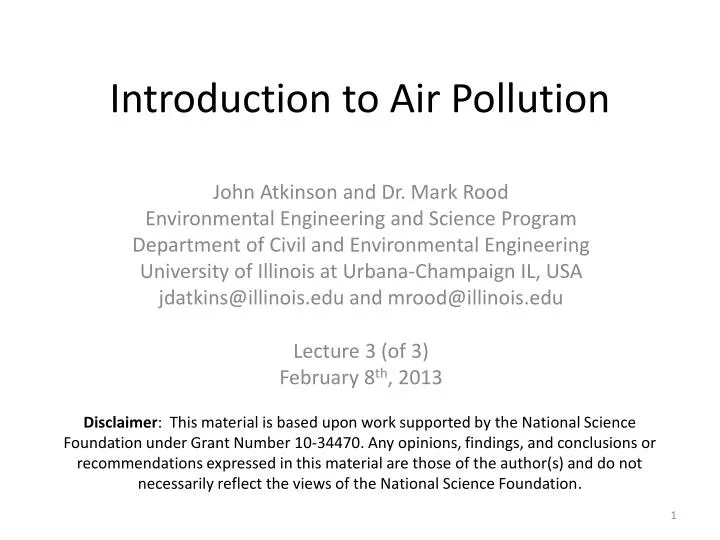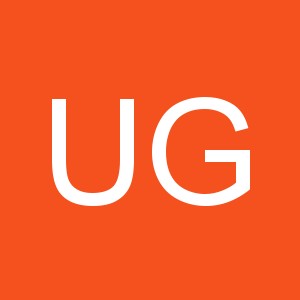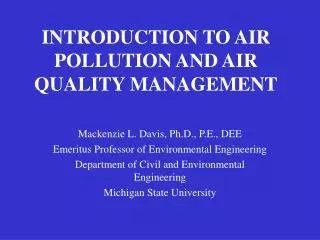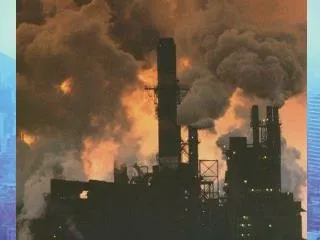

Introduction to Air Pollution
Jul 26, 2014
320 likes | 1.55k Views
Introduction to Air Pollution. John Atkinson and Dr. Mark Rood Environmental Engineering and Science Program Department of Civil and Environmental Engineering University of Illinois at Urbana-Champaign IL , USA [email protected] and [email protected] Lecture 3 (of 3)
Share Presentation
- twinotter html
- champaign il
- mark rood environmental engineering
- new permitting requirements
- clean air act amendments

Presentation Transcript
Introduction to Air Pollution John Atkinson and Dr. Mark Rood Environmental Engineering and Science Program Department of Civil and Environmental Engineering University of Illinois at Urbana-Champaign IL, USA [email protected] and [email protected] Lecture 3 (of 3) February 8th, 2013 Disclaimer: This material is based upon work supported by the National Science Foundation under Grant Number 10-34470. Any opinions, findings, and conclusions or recommendations expressed in this material are those of the author(s) and do not necessarily reflect the views of the National Science Foundation.
Outline Important Air Quality Regulations Clean Air Act and Amendments Others Methods for Quantifying Pollutants Air Pollution Control Field Trip to Bondville Atmospheric Environmental Research Station (BEARS) Summary
Air Pollutant Regulations • Regulations Prior to 1970 (1955, 1963, 1967) • Provided funds to research air pollution monitoring and abatement techniques • Began to develop emission inventories for select pollutants
Air Pollutant Regulations • Clean Air Act (1970) – Created federal regulations on emissions for select contaminants from stationary and mobile sources • National Ambient Air Quality Standards (NAAQS) • State Implementation Plans (SIP) • New Source Performance Standards (NSPS) • National Emission Standards for Hazardous Air Pollutants (NESHAPs) • Contributed to the development of the US EPA • Small amendments made in 1977
Air Pollutant Regulations • Clean Air Act Amendments (1977) – Updates to the previous CAAA that address specific air quality issues • States must submit revised SIPs • Classification of areas with respect to NAAQS • Establish policies for non-attainment areas • New major facilities must apply specific standards • Good Engineering Practice for stack height
Air Pollutant Regulations • Clean Air Act Amendments (1990) – Updates to the initial Clean Air Act that address specific problems and increased ability to control and detect pollutants • Control of Acid Rain • Control of Hazardous Air Pollutants • Control of Ozone Depleting Chemicals • New Requirements for Motor Vehicles • New Permitting Requirements for Sources
National Ambient Air Quality Standards • Standards set for the six criteria air pollutants • Primary Standard – Protection of health • Secondary Standard – Protection of welfare • Pollutant Concentrations • Averaging Times – Average pollutant concentration during a given amount of time (to remove outliers)
National Ambient Air Quality Standards Source: US EPA
Monitoring/Measuring Air Pollutants • What Effects an Air Pollutant’s Concentration? • Location of Source Compared to Receptor (x, y, z) • Type of Source (stationary, mobile, area) • Source Strength • Atmospheric Conditions • Wind Speed/Direction • Precipitation • Atmospheric Stability
Gaussian Dispersion Model Determining contaminant concentrations resulting from a stationary pollutant source… Q = Source Strength (mass / time) ug = Wind Speed (length / time) σy and σz= Parameters Describing the Weather Conditions (length) (x, y, z) = Position of Interest H = Height of Pollutant Source (length)
Atmospheric Conditions Impact Pollutant Dispersion
Radioactive Materials from Fukushima Detected at Sites in the USA Weatherbee, et al., Environmental Science and Technology, 2012
Radiation Dispersion (and decay) from the Chernobyl Disaster Bq/m3 of 137Cs Bq = Becquerel (SI Unit for Radioactivity) Quelo, et al., Atmospheric Environment, 2007
Sulfur Dioxide Emissions from Abbott Power Plant µg/m3 • AERMOD model from EPA
Types of Air Pollutant Monitoring Outdoor Ambient Monitoring is the systematic, long-term assessment of pollutant levels by measuring the quantity and types of pollutants in the outdoor air. Emissions Measurement is the process of monitoring particulate and gaseous emissions from specific sources.
National Trends Network Measurement Sites http://nadp.sws.uiuc.edu/lib/manuals/opman.pdf IL 11 = Bondville, IL – Tour of this site next week!
Ambient Atmospheric Sampling at Bondville Environmental Atmospheric Research Site
Ambient Atmospheric Sampling at Bondville Environmental Atmospheric Research Site • Basic Air Quality • Sulfur dioxide, ozone, particulate matter, organics • Precipitation Chemistry • Major ions, mercury, event based longer term sampling • Long-Term Climate • National Weather Service site • On-Site Meteorology • Wind velocity, air and soil temperatures, dew point temperature, pressure, radiation • Atmospheric Visibility • Solar Physics • Continuous Particulate Monitoring using Chromatographic Methods
Sampling Platforms – Ships NOAA Research Vessel: Ronald H. Brown http://www.moc.noaa.gov/rb/
Sampling Platforms – Aircraft NOAA DHC-6 Twin Otter Aircraft http://www.noaanews.noaa.gov/stories2009/20090112_twinotter.html Satellites Balloon http://www.ncdc.noaa.gov/weather-balloon-data http://www.nasa.gov/vision/earth/lookingatearth/earthweek.html
Sampling Platforms – Personal Samplers http://www.munroinstruments.co.uk/Environmental/contents/en-us/d27_Standard_Personal_Air_Samplers.html
Stack Sampling
Air Pollution Control • Major Techniques • Adsorption – Adhesion of a contaminant to the surface of a solid • Volatile Organic Compounds • Mercury • Absorption – Concentration of a contaminant into the bulk of another solid or liquid • Sulfur Dioxide • Carbon Dioxide (?) • Filtration – Removing solids/liquids from a gas stream by imposing an impenetrable barrier • Particulate Matter • Catalytic Destruction – Conversion of a contaminant to an inert compound via catalytic processes • Nitrogen Oxides (Catalytic Reduction to N2)
Next Week… (Thursday) • Tour of Bondville Environmental and Atmospheric Research Site (BEARS)
- More by User

EOH 3101 INTRODUCTION TO AIR POLLUTION
EOH 3101 INTRODUCTION TO AIR POLLUTION. WHY IS AIR IMPORTANT? DAILY INTAKE H 2 O : 1-3 kg FOOD : 1-2 kg AIR : 10-25 kg. AIR POLLUTION.
1.07k views • 70 slides


INTRODUCTION TO AIR POLLUTION AND AIR QUALITY MANAGEMENT
INTRODUCTION TO AIR POLLUTION AND AIR QUALITY MANAGEMENT. Mackenzie L. Davis, Ph.D., P.E., DEE Emeritus Professor of Environmental Engineering Department of Civil and Environmental Engineering Michigan State University . Topics. History of Air Pollution Air Pollution Episodes
871 views • 15 slides

AIR POLLUTION
AIR POLLUTION. Having trouble breathing?.
650 views • 23 slides

Air Pollution
Air Pollution. Chapter 18. Core Case Study: South Asia’s Massive Brown Cloud. Asian Brown Cloud Causes Chemical composition Areas impacted Air pollution connects the world Steps taken in China and India to reduce air pollution. The Asian Brown Cloud.
1.11k views • 78 slides

Air Pollution: An Introduction
Air Pollution: An Introduction. CE/AE/EnSci 524 January 2010. Slides noted as AWMA are from: Understanding Air Quality from the Air and Waste Management Association Do not make copies of these slides for distribution. What are the main concerns?. What is air pollution?.
1.43k views • 78 slides

Air Pollution. G. Tyler Miller’s Living in the Environment 13th Edition Chapter 17. Key Topics. Key Topics. Structure and composition of the atmosphere. Types and sources of outdoor air pollution. Types, formation, and effects of smog. Sources and effects of acid deposition.
1.12k views • 41 slides

1. Air Pollution. Group 13 Matt Moerbe, Brett Roberts, Ann-Marie Scarborough, Tyler Goodall, Trevor Quick . http://i.huffpost.com/gen/1240209/thumbs/o-POLLUTION-facebook.jpg. 2. What is Air Pollution?. The release of harmful substances that can harm the environment and humans
2.5k views • 37 slides

Air Pollution. By: Chrissy Badalamenti , Amie Maxwell and Mitch Miller. What is air pollution?. There are two main types of air pollution: Ozone and Particle pollution. There is also indoor and outdoor pollution Ozone is a colorless and odorless gas.
848 views • 13 slides

Air Pollution. Air pollution kills an estimated 2.7 million to 3.0 million people every year — about 6% of all deaths annually. Source: UN Human Development Report New York, UN, 1998.
600 views • 17 slides

Solutions to Air Pollution
Solutions to Air Pollution. - motor vehicle use and manufacturing grew. 1. 1900-1970. - air in cities became more polluted. - nitrogen oxide increased 1000%. Air Pollution Control Act of 1955 Clean Air Act of 1963 Clean Air Act of 1970 Clean Air Act of 1990. 2. Air Pollution Laws.
545 views • 10 slides

Air Pollution. Chapter 18. Core Case Study: South Asia’s Massive Brown Cloud. Asian Brown Cloud Causes Chemical composition Areas impacted Air pollution connects the world Steps taken in China and India to reduce air pollution The winter of 2012/2013 has been bad!.
1.05k views • 48 slides

Air Pollution. By: Admir Basha Period 1. Background Information. It can effect anyone Minimal exposure can cause respiratory and inflammatory problems Severe exposure can cause heart disease and cancer It can also cause damage to animals and plants. Canada Emissions.
313 views • 8 slides

AIR POLLUTION . Colin Davidson Chase Duffey Kevin Erbs Kevin Kane Ben Loerke Abigail McLean. Why is it a constant issue?. Everyday the average person inhales 20,000 liters of air Air pollution can be both indoors and outdoors Problem to both humans and nature Air pollution travels .
696 views • 27 slides

Air Pollution . By: Sarah Kreps. Air Pollution is the most widespread and obvious kind of pollution. 147 million metric tons of air pollution (excluding CO2 and wind blown dust and soil) are released into the air from human activity alone in the United States
599 views • 29 slides

Air Pollution. Thank God men cannot fly, and lay waste the sky as well as the earth. - Henry David Thoreau. CLIMATE PROCESSES AND AIR POLLUTION. Air pollution is defined as any contaminant added to the air that is harmful to the health of living organisms.
930 views • 41 slides

Introduction to Air Pollution. John Atkinson and Dr. Mark Rood Environmental Engineering and Science Program Department of Civil and Environmental Engineering University of Illinois at Urbana-Champaign [email protected] and [email protected] Lecture 1 (of 3) February 5 th , 2013.
522 views • 24 slides

Air Pollution. By: Amyre martin and Paige cheeks. Air pollution kills millions of people every year. Types of chemicals. Invisible and scentless gases. Carbon Dioxide- Carbon monoxide Sulphur oxide. Picture collage. Countries with high air pollution. The greenhouse effect.
936 views • 15 slides

Air Pollution. SVN3E. Burning fossil fuels creates not only greenhouse gases but also smog. Smog. Smog is mostly ground-level ozone (O 3 ), created when sunlight acts on methane and nitrogen oxide gases. Smog.
741 views • 12 slides

Air Pollution. Module-2. Module-2. Ambient air pollution monitoring: techniques and instrumentation; monitoring stations Stack monitoring: techniques and instrumentation. Experimental analysis: gaseous and particulates; standards and limits. Lecture-1 Ambient Air Pollution Monitoring.
845 views • 44 slides

Air Pollution. Outdoor Air Pollution. Air Pollution. Sources Transportation Stationary sources Industrial Issues Global warming Ozone depletion Acid rain Poisons Remedies Prevention Removal Legislative Issues. Air Pollution Index. Major Air Pollutants. Cars, Planes, Trains….
904 views • 47 slides

Air Pollution. Heather Price. http://www.pscleanair.org/airq/visibility/. Air Pollution. What is it? Where does it come from? How does it impact our health?. What is air pollution?. Gases: Carbon Monoxide (CO) Ozone (O 3 )
594 views • 24 slides

Air Pollution. Composition. Nitrogen: 78.1% Oxygen: 20.9% Other Gases: Argon : 0.9% CO 2 : ~ 370 ppm: Green House Gas Methane: Green House Gas Ozone: blocks UV radiation Dust: solid particles in the atmosphere Water Vapor: a major player in atmospheric circulations
902 views • 58 slides

IMAGES
VIDEO
COMMENTS
This document discusses air pollution, including its definition, types, sources, causes, and effects. It defines air pollution as the introduction of harmful materials into the atmosphere, causing health and environmental damage. The main types are primary and secondary pollutants.
Covering topics such as major pollutants, health impacts, urban air quality, and sustainable practices, this presentation equips viewers with a comprehensive understanding of the complexities surrounding air pollution.
Lesson objectives. Understand why clean air is important. Understand experiments we can do to prove air pollution exists. Understand where air pollution can come from. What is air?...
The document discusses air pollution, defining it as the discharge of foreign substances into the air that adversely affect air quality and harm human, plant, and animal life. It classifies air pollutants, sources of pollution, effects of pollution, and methods for controlling pollution.
Here are the key messages we’ll cover in Module 11. In summary, air quality, climate, and health intersect in many ways. CLICK to see each key message and sub message. Fuel combustion is responsible for most of the air pollutants that adversely affect human health.
Made to control air pollution on a national level. Requires the EPA to develop and enforce regulations to protect the general public from exposure to airborne contaminants that are known to...
This Air Pollution PPT contains 17 amazing slides with rich content and stunning illustrations for all kind of seminars and presentations. Download FREE Air Pollution PPT today.
Air Pollution is the most widespread and obvious kind of pollution. 147 million metric tons of air pollution (excluding CO2 and wind blown dust and soil) are released into the air from human activity alone in the United States
Air Pollution - Free download as Powerpoint Presentation (.ppt / .pptx), PDF File (.pdf), Text File (.txt) or view presentation slides online. Air pollution is a mixture of solid particles and gases in the air from sources like vehicle emissions, factory chemicals, and dust.
Presentation on Air Pollution - Free download as Powerpoint Presentation (.ppt), PDF File (.pdf), Text File (.txt) or view presentation slides online. Pollution is the introduction of contaminants into the environment that causes harm. Air pollution occurs when harmful substances affect the atmosphere.